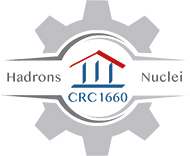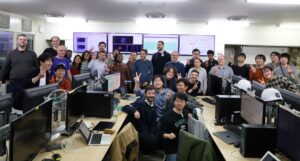 The German Research Foundation (DFG) approved the establishment of the CRC 1660 "Hadrons and Nuclei as Discovery Tools" at Johannes Gutenberg Unversity. This newly granted Collaborative Research Centre will allow for an interdisciplinary approach to the search of new physics phenomena, and it will significantly sharpen our understanding of strong interaction processes.
The German Research Foundation (DFG) approved the establishment of the CRC 1660 "Hadrons and Nuclei as Discovery Tools" at Johannes Gutenberg Unversity. This newly granted Collaborative Research Centre will allow for an interdisciplinary approach to the search of new physics phenomena, and it will significantly sharpen our understanding of strong interaction processes.
By bringing together the fields of atomic, nuclear, and hadron physics, this project holds a unique discovery potential along three main research pillars.
In the first pillar, experiments at low energies and high intensities are used to search for new particles (e.g. dark matter particles) and interactions beyond the SM, and the results are interpreted using lattice QCD. The second pillar investigates the interface between hadron and nuclear physics through spectrometry experiments, electron and photon scattering experiments and high-precision calculations that will improve the interpretation of neutrino experiments and the description of muonic atoms. The third pillar focuses on the exploration of nuclear astrophysics and multi-messenger astronomy with a new generation of high-precision experiments in low-energy nuclear physics combined with state-of-the-art theoretical calculations using effective field theories.
The very broad combined expertise in atomic, nuclear and hadronic physics within this CRC will allow for a significant impact on all the above research avenues simultaneously. The outstanding opportunities enabled by the new local MESA accelerator, which is coming online, as well as at the MAMI (Mainz), BESIII (China), and PSI (Switzerland) facilities, combined with the very strong interplay between the theoretical and experimental groups, will foster unique physics and methodological connections between the different research fields and create a favourable environment for discoveries.
For more information, please read the Johannes Gutenberg University's press release.
 Laura Klöpper successfully completed her bachelor thesis "Aufbau eines Teststands und Charakterisierung von Li-Glas-Neutronendetektoren" as well as her final exam and was awarded the title of Bachelor of Science (B.Sc.).
Laura Klöpper successfully completed her bachelor thesis "Aufbau eines Teststands und Charakterisierung von Li-Glas-Neutronendetektoren" as well as her final exam and was awarded the title of Bachelor of Science (B.Sc.).
 The next two weeks will be dedicated to taking more data on our precious 208Pb target. Together with the last beam time, this will, hopefully, allow us to extract the
The next two weeks will be dedicated to taking more data on our precious 208Pb target. Together with the last beam time, this will, hopefully, allow us to extract the  The German Research Foundation (DFG) approved the establishment of the CRC 1660 "Hadrons and Nuclei as Discovery Tools" at Johannes Gutenberg Unversity. This newly granted Collaborative Research Centre will allow for an interdisciplinary approach to the search of new physics phenomena, and it will significantly sharpen our understanding of strong interaction processes.
The German Research Foundation (DFG) approved the establishment of the CRC 1660 "Hadrons and Nuclei as Discovery Tools" at Johannes Gutenberg Unversity. This newly granted Collaborative Research Centre will allow for an interdisciplinary approach to the search of new physics phenomena, and it will significantly sharpen our understanding of strong interaction processes.


 AG Sfienti is currently in Bormio, Italy, participating in the International Winter Meeting on Nuclear Physics
AG Sfienti is currently in Bormio, Italy, participating in the International Winter Meeting on Nuclear Physics